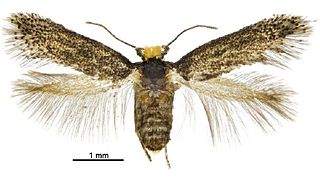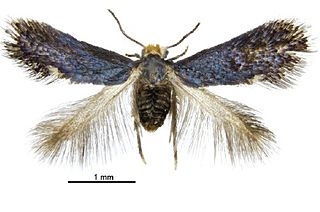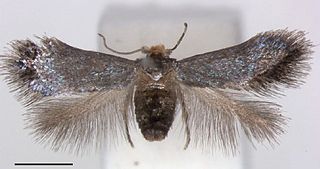
Stigmella crataegella is a moth of the family Nepticulidae found in Europe. It was described by the Austrian entomologist Josef Wilhelm Klimesch in 1936. The larvae mine the leaves of hawthorns.

Ectoedemia agrimoniae is a moth of the family Nepticulidae. It is found from Fennoscandia to the Pyrenees, Italy and Greece, and from Great Britain to Ukraine.
Stigmella atrata is a moth of the family Nepticulidae. It is endemic to New Zealand and has been observed on the North Island, South Island and Stewart Island. The larvae of this species are leaf miners of Brachyglottis elaeagnifolia and Brachyglottis rotundifolia and have been recorded in April, May, July and September. Larvae pupate on the ground in a cocoon. Adults have been observed on the wing in January, February, November and December. It has been hypothesised that there is probably only one generation per year.

Stigmella cypracma is a species of moth of the family Nepticulidae. It is endemic to New Zealand and has been observed in the North and South Islands. The larvae of this species are leaf miners and pupate within their mines. The larval host species is Brachyglottis repanda. Adult moths are on the wing in February and September to November. This species has two generations per year.

Stigmella fulva is a moth of the family Nepticulidae. It is endemic to New Zealand and has been observed in the North Island around Mount Taranaki, in the South Island and at Stewart Island. The species' eggs are laid singly but a considerable number may be deposited on the upper surface of one leaf. The incubation period can last from a week to a month depending on climatic conditions. The larvae mine the leaves of their host plants which are all in the genus Olearia. Larvae have been recorded in all months except January, February and June. The cocoon is brown and spun amongst the leaf litter under its host plant. The pupal period has been shown to range from 21 days to 79 days, again depending on climatic conditions. Adults have been observed on the wing January until March and August to December. They are active in the sun about their larval food plant.

Stigmella ilsea is a moth of the family Nepticulidae. It is endemic to New Zealand and has been observed in the North and South Islands. The larvae of this species are leaf miners and feed on Olearia virgata, Olearia rugosa, Olearia odorata, Olearia laxiflora, Olearia lineate and Olearia hectorii. The mine starts as very narrow gallery, but the full-grown larva occupies all space between the cuticles, leaving nothing but a small, empty bladder. Larvae have been recorded from February to May and in July and September. The cocoon is pale brown and is spun in detritus on the ground underneath the host plant. Adult moths have been recorded in January, October and November. Reared specimens emerged from July to September. There is likely one generation per year.

Stigmella kaimanua is a moth of the family Nepticulidae. This species is endemic to New Zealand and has been observed in the southern parts of the South Island. S. kaimanua inhabits lowland and lower montane forest. The larvae mine the leaves of Parsonsia heterophylla. The mine is linear and continues down the stems for a short distance. Larvae have been observed April to August. The cocoon is probably attached to the leaf litter on the ground under the host plant. There is one generation per year. Adults are on the wing in November and December and are attracted to light.

Cosmopterix callichalca is a moth of the family Cosmopterigidae. It is known from Argentina (Salta), Brazil and the United States

Cosmopterix pulchrimella, the beautiful cosmopterix moth, is a moth of the family Cosmopterigidae. It is known from the United States and Canada. It is also present in the Palearctic realm, where it is known from the Mediterranean Basin, from Portugal to the western Transcaucasus, north to Switzerland and Hungary. It has also been recorded from the Azores, the Canary Islands and Madeira. It has recently been found in southern England.

Pancalia leuwenhoekella is a moth in the family Cosmopterigidae.

Pectinivalva mystaconota is a moth of the family Nepticulidae. It is known from scattered localities in eastern Australia from Wellington, New South Wales south to Mount Nelson, Hobart, Tasmania.

Pectinivalva brevipalpa is a moth of the family Nepticulidae. It is found in New South Wales.

Pectinivalva minotaurus is a moth of the family Nepticulidae. It is found in southern Queensland.

Pectinivalva acmenae is a moth of the family Nepticulidae. It is found in New South Wales.

Pectinivalva quintiniae is a moth of the family Nepticulidae. It is found in northern New South Wales and southern Queensland.

Pectinivalva tribulatrix is a moth of the family Nepticulidae. It is found in northern Queensland.

Pectinivalva xenadelpha is a moth of the family Nepticulidae. It is found in Borneo, east Kalimantan.
Roscidotoga lamingtonia is a moth of the family Nepticulidae. It is found in southern Queensland and northern New South Wales.
Ectoedemia rosae is a moth of the family Nepticulidae. It is found in France and Norway (Vang).
Elachista kobomugi is a moth in the family Elachistidae. It was described by Sugisima in 1999. It is found in Japan on the islands of Hokkaido and Honshu.















